Confidence Building
Many dogs with reactivity problems are also very insecure. Instead of trying to work through the trigger head on, I’m a big fan of giving the dog a good foundation training first, identifying the root cause of the reactivity, and working on improving the whole dog. This often reduces the intensity of the reactivity significantly, making it much easier to work through and more fair to the dog. If your dog struggles with over excitement, you can use these exercises to increase body awareness and focus, but also check out our posts on calmness.
The idea is to take every opportunity you encounter on your daily walks to help your dog to overcome small scary challenges to your dog’s confidence, and increase you dog’s trust in you.
This video obviously concerns horses (click to view), and I have to admit that I don’t know much about the trainer, but I think it gives a really nice overview of how to tackle smaller challenges in order to overcome bigger challenges.
The very first step is to start working your dog through things he/she gets spooked by (like bins, plastic bags, or rattling objects – obviously not people, dogs or moving vehicles!). Allow your dog to approach the object at his/her own pace, keeping the leash relaxed, until the dog is comfortable sniffing and examining the object. The second step is to start marking and rewarding the dog for approaching, smelling, and pawing the object. By making it into a game you can increase engagement, acting like as a team building exercise! Keeping the dog focused on the handler while doing fun things makes the dog more relaxed outside, and less concerned about the environment.
Go looking for scary objects on the walk and use your environment as an obstacle course that you can help your dog successfully go through. The two main behaviours I use are touching the object with two paws, and jumping up on different objects and holding a Sit or Down Stay. I have been doing this a lot with our new dog Ida who is a bit nervous about loud sounds like trucks and buses, and who can get overwhelmed by all the different things in the city. I will typically go up to an object and ask her “Ready?” which gets her to examine whatever thing we are standing in front of. Once she has had a good sniff I’ll tell her Touch and let her put her paws on the object once or twice. When she seems comfortable I build in some duration, telling her Touch and Stay, dropping the leash and walking away for a few meters before returning and rewarding her in the position before releasing her. Getting the dog to jump up on different objects and hold a Sit or Down Stay is usually quiet easy once the dog knows the game.
I like to teach the dog to touch different things with its nose and paws inside before transferring it to other environments. Click on the names to see videos on how to teach these behaviours; Emily Larlham on how to teach a nose touch, and Micheal Ellis on how to teach a paw touch
When you have been playing or doing trick training with your dog outside, I always like to end the exercise on a calm note. I always sit down with the dog for 10-15 minutes and help it to relax while calmly taking the environment in.
Happy Training!
For more ideas on how to use your environment for confidence building, visit Dogparkour Sweden's youtube channel.

